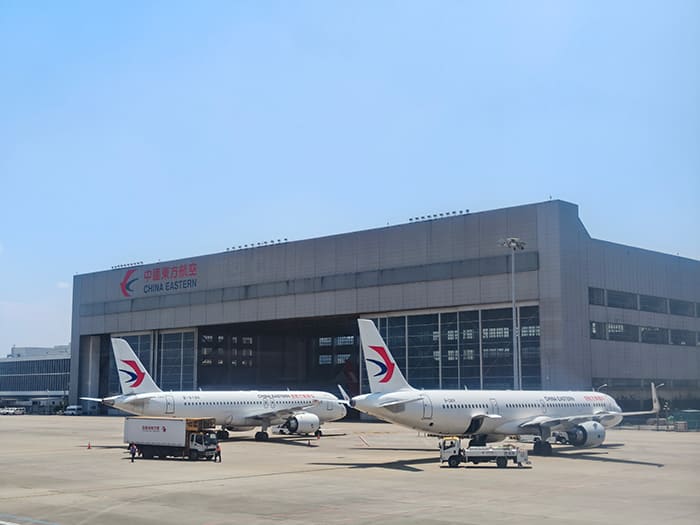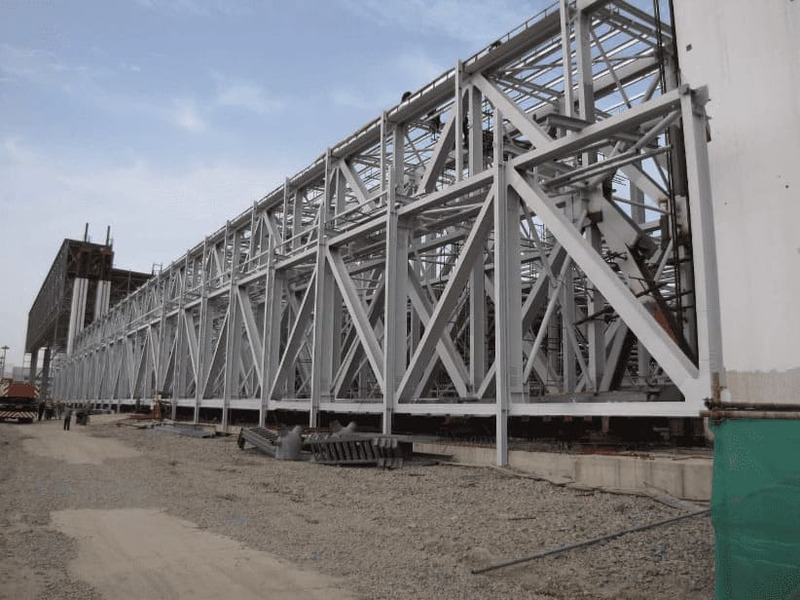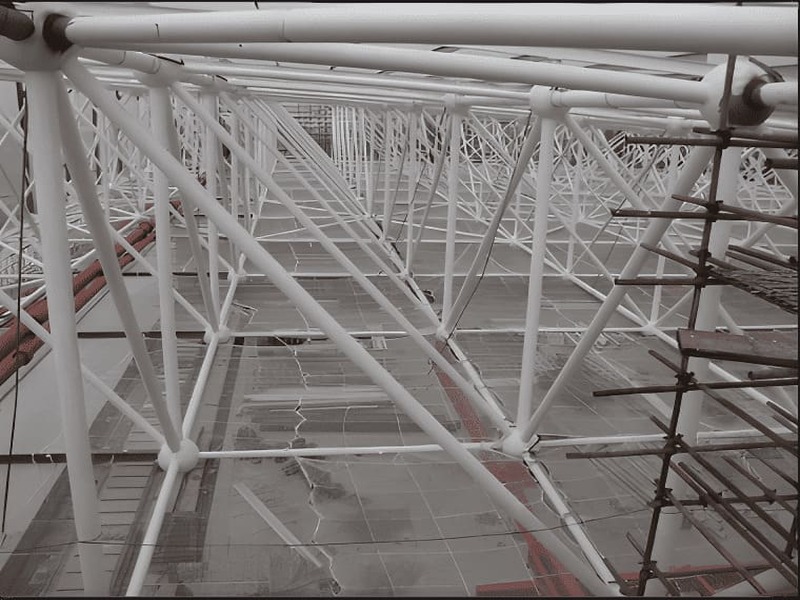1. Which types of metal hangar building are suitable for steel structure construction?
1.1 Frame structure (large civil aviation hangar, military maintenance metal hangar)
- Spatial breakthrough: The use of bolt-ball node grid can achieve a 150-meter single-span column-free space, which is equivalent to the horizontal connection of 21 standard basketball courts. It eliminates the interference of traditional columns on aircraft entry and exit and lifting operations, and improves space utilization by more than 30%.
- Construction efficiency: The rate of prefabricated modular components in the factory reaches 90%, and the on-site assembly period is shortened by 50% compared with the traditional mode. The main structure of the 50,000 m2 metal hangar building can be completed in only 150 days, meeting the needs of rapid commissioning of the new airport.
- Load upgrade: The roof load is designed to reach 5kN/㎡, and it is equipped with an intelligent lifting system (monorail crane with a load capacity of 50t+), which can meet the needs of complete aircraft maintenance and component disassembly and assembly of heavy passenger aircraft such as Boeing 747 and Airbus A380.
- Innovation in shape: The curved grid structure supports complex shapes such as arcs and domes (such as the “seagull spreading wings” shaped metal hangar at a coastal airport), and is combined with a large area of Low-E glass curtain wall to achieve a fusion of natural lighting and architectural aesthetics.
- Cost reference: The unit cost is about $400-550 USD/㎡. In large-span scenarios, the comprehensive cost is 30% lower than that of the concrete solution.
1.2 Portal steel frame structure (general aviation metal hangar, maintenance workshop)
- Flexible adaptation: Single span is available in 30-80 meters, and eave height is 10-25 meters, which can meet the parking and modification needs of multiple aircraft types such as regional aircraft, business jets, and helicopters, and can be quickly divided into a complex functional space of “maintenance area + storage area + office area”.
- Extremely fast construction: Modular steel column + steel beam system, the main structure of the 20,000 m2 hangar can be completed within 60 days, and is equipped with a detachable enclosure system to support “expansion while operating” to meet the needs of rapid expansion of aviation business.
- Intelligent upgrade: integrated intelligent lighting system (automatic adjustment of light intensity), mechanical ventilation system (20 air changes per hour), temperature and humidity monitoring system to create a precise maintenance environment with constant temperature and humidity.
- Environmental advantages: Steel structure components are 100% recyclable, construction waste is reduced by 90%, carbon emissions are 60% lower than concrete, and they meet green airport certification requirements (such as LEED and GB/T 51133).
- Cost reference: Unit cost is $280-400 USD/㎡, suitable for small and medium-sized aviation bases and temporary operation and maintenance facilities.
2. Why do global aviation hubs prefer steel structure hangars?
2.1 Super-scale space, releasing unlimited possibilities
Adopting GB, EN, and AISC design specifications, high-strength steel (Q355B S355JR A572 SM490A) is used to achieve a column-free super-large clear span. A single hangar can accommodate 5-8 wide-body aircraft for simultaneous operation. The detachable roof hanging point system (load 10t/point) supports 360° three-dimensional maintenance operations, which is 40% more efficient than traditional ground maintenance. The open space design is adapted to emerging needs such as drone cluster maintenance and new energy aircraft charging, and no structural demolition is required for future transformation.
2.2 Lightning construction, seize the aviation initiative
The “factory prefabrication + on-site assembly” mode shortens the construction period: the main structure of the 30,000 square meters metal hangar was completed in 90 days, which is 270 days shorter than the concrete solution, helping the airport to seize the initiative in airline bidding. The modular interface design supports “phased construction and gradual expansion”, reducing the construction cost of the first phase by 40%, and the subsequent expansion will not affect the existing operation.
2.3 Green infrastructure, responding to ESG strategy
The annual power generation of the photovoltaic integrated roof (BIPV system) covers 30% of the metal hangar’s electricity consumption. With a ground source heat pump and an intelligent energy management system, the comprehensive energy saving rate reaches 40%. The exterior wall adopts a 300mm rock wool sandwich panel (sound insulation 65dB) to reduce noise interference to the surrounding community; the reuse rate of detachable components exceeds 85%, and the carbon footprint of the whole life cycle is reduced by 55%.
2.4 Hard-core safety, escort aviation operation, and maintenance
The earthquake resistance is 8 degrees, the wind resistance level is 12 (can withstand 32.7m/s strong wind), and the anti-continuous collapse design has been certified by the National Construction Engineering Quality Supervision and Inspection Center. The intelligent fire protection system (early smoke detection + automatic sprinkler) is linked with the emergency evacuation simulation system to ensure the safety of the thousand-person operation scene. The Internet of Things monitoring module tracks the structural stress and equipment operation status in real time, and the early warning response time is less than 10 seconds.
3. Application scenarios of steel structure hangar
| Scene Type | Technical Solution | Core Performance | Cost reference |
| Large civil aviation hub hangar | 150m long span grid + intelligent lifting system | A single hangar can accommodate 6 A380s, with an annual maintenance capacity of over 200 flights | $600-800 USD/㎡ |
| Military aviation maintenance base | Portal steel frame + explosion-proof wall system | Explosion-proof grade 0.2MPa, supports fighter/transport aircraft mixed operation | $750-950 USD/㎡ |
| General Aviation Industrial Park Hangar | Modular steel structure + quick-install roof | 5,000㎡ temporary hangar built in 48 hours, single module expansion | Single module $150,000 |
| Aircraft Modification R&D Center | Grid + Adjustable Floor System | Ground load 15kN/㎡, supports complex operations such as landing gear modification and cabin reconstruction | $550-700 USD/㎡ |
4. Steel structure vs. traditional concrete: In-depth comparison of hangar scenes
| Core indicators | Steel structure scheme | Traditional concrete solution |
| Maximum single span | 150 meters of column-free space | ≤40 meters (need dense columns) |
| 30,000㎡Construction period | 90 days to complete the main construction | 360 days (including maintenance) |
| Maintenance flexibility | Modular equipment belt can be quickly disassembled and assembled (lifting point shift can be completed in 2 hours) | Equipment transformation requires dismantling of structures, cycle ≥ 7 days |
| Carbon emissions | 1.5tCO₂/㎡ (67% reduction) | 4.5tCO₂/㎡ |
| Renovation cost | Adjustment of local components reduces costs by 80% | Structural demolition generates a lot of construction waste and is costly |
| Earthquake resistance | Level 8 | Level 6-7, high-intensity areas need reinforcement |
5. Key Components and Technical Standards
5.1 Load-bearing system
- Steel columns: Made of Q355B S355JR A572 SM490A high-strength steel, with a compressive strength of 460MPa, the column spacing can reach 20 meters, reducing the number of hangar columns by more than 30%.
- Space grid: upright tetrahedral pyramid system, optimized wind load of 1.2kN/㎡ through wind tunnel test, maximum cantilever length of 25 meters, meeting the load requirements of aircraft wing maintenance platform.
- Hoisting system: Equipped with European double-beam crane (lifting capacity 100t) + intelligent anti-sway control system, positioning accuracy ±5mm, supports precise lifting of aircraft engines.
5.2 Roof and enclosure system
- Smart roof: three-layer corrugated steel plate + 200mm insulation cotton + photovoltaic glass (transmittance 60%), the thermal insulation performance is improved by 40% in winter, and the indoor temperature is reduced by 5℃ in summer through the ventilation ridge.
- Fast opening and closing door: electric sliding door (single door area exceeds 1000㎡), opening and closing speed 0.3m/s, equipped with a radar anti-collision system to ensure the safety of aircraft entry and exit.
- Explosion-proof wall: It adopts a steel frame + fiber cement explosion-proof panel (explosion-proof pressure 0.15MPa), which is used to isolate dangerous areas such as the fuel storage area and the welding workshop.
6. Frequently Asked Questions
Q1: How to estimate the construction cost of a steel hangar? What factors will directly affect the cost?
A: Steel hangar costs about $800–1500 per m², depending on size and requirements. Larger spans or heights add 15–20%, while coastal wind or seismic standards raise costs by ~30%. Extra facilities like cranes, smart lighting, or insulation add 20–40%. High-strength steel costs 15–20% more but lasts longer. Labor, transport, and site conditions also affect the final price.
| Compare Projects | Steel structure hangar construction method | Traditional construction method |
| Comprehensive cost | $ 800- 1500 USD / square meter, subject to dynamic adjustment due to various factors | Usually higher than steel structure hangars, with a large proportion of material and labor costs |
| Span and headroom impact | Large span, high clearance, and enhanced structural design, cost increase of 15%-20% | Also affected by span and headroom, but structural modification is difficult, and the cost increase may be higher |
| Load requirements affect | The cost of materials and processes for coastal typhoon and earthquake-resistant projects increased by about 30% | To cope with special load requirements, a lot of foundation reinforcement and material upgrades are needed, and the cost increase may exceed that of steel structures. |
| Functional configuration impact | Additional facilities increase costs by 20%-40% | The flexibility of functional configuration adjustment is low, and adding or modifying functions can easily lead to an extended construction period and significantly increased costs. |
| Material properties | There are various types of steel materials. High-strength steel is expensive but has excellent weather resistance. | Mostly made of masonry, concrete, etc., the durability is relatively poor, and the later maintenance cost is high |
| Construction period | Prefabricated components are assembled on site, with a fast construction speed and a short construction period | There are many processes, such as on-site pouring, which are greatly affected by factors such as weather, and the construction period is long. |
| Environmental protection | Recyclable, less construction waste | Generates a large amount of construction waste, which has a great impact on the environment |
Q2: Can the steel structure hangar meet the requirements of personalized customization?
A: Whether for a Boeing 747 or Airbus A380, hangar space can be flexibly planned for parking and maintenance. Designs often feature column-free spans over 60m, functional zones like fuel storage and climate-controlled equipment areas, curved roofs with siphon drainage, and coordinated exteriors using metal curtain walls and fluorocarbon finishes. Some projects also include smart systems for real-time load monitoring and automatic fire alarms, ensuring efficiency and safety.
| Comparison Dimensions | Customized design of a steel structure hangar | Traditional construction method |
| Design Flexibility | Full process customization, which can optimize the space layout according to the parking and maintenance needs of different aircraft models (such as Boeing 747 and Airbus A380) | The design is relatively fixed, and it is difficult to meet the personalized needs of special models and scenarios |
| Spatial structure | The column-free large-span structure is adopted, with a single span of more than 60 meters, which can meet the needs of multiple cameras working simultaneously. | Most of them are supported by columns, which affects the utilization of space and makes it difficult to achieve a large-span working space. |
| Functional division | It can realize fine functional zoning, such as explosion-proof and fire-proof fuel storage area, precision equipment area with temperature and humidity control, etc. | The functional division is simple and rough, which makes it difficult to meet the needs of complex functions. |
| Roof drainage | The curved roof reduces wind resistance, and the siphon drainage system solves the drainage problem of large-area roofs | The roof design is simple, the drainage system is easily affected by the weather, and the drainage efficiency is low |
| Design | The style is unified with the airport buildings through metal curtain walls and fluorocarbon paint finishes. | The exterior style is fixed and lacks coordination with the surrounding environment |
| Intelligent integration | Can integrate intelligent systems such as load monitoring and fire linkage to improve efficiency and safety | Low level of intelligence, mostly dependent on manual operation and management |
Q3: How long does it take to build a steel hangar from design to completion? Will the construction be affected by the season or weather?
A: Generally speaking, it takes 60-120 days to build a steel hangar. Compared with traditional cement buildings, most of the steel structures are prefabricated in factories, and the on-site construction is less than half. Work can be done in winter below -10℃. With BIM technology and digital processing, each link is faster, and the construction is faster and accurate.
| Compare Projects | Steel structure hangar construction method | Traditional concrete structure construction method |
| Overall construction period | Standard construction period: 60-120 days | Long construction period, no clear prefabrication link, long on-site operation time |
| Construction phase division | Design deepening (15-20 days), factory prefabrication (25-35 days), on-site installation (20-30 days) | There is no prefabrication stage, the on-site operation time accounts for a large proportion, and the construction period division is not clear |
| On-site operation | High degree of prefabrication, reducing on-site wet work by more than 50% | There are many wet operations on site |
| Season and weather effects | Construction is still possible in low temperature environments (below -10°C) in winter. Only rainy season or extremely windy weather may extend the construction period by 5-10 days. | Affected by seasons and weather, bad weather such as low temperature and rainy season has a significant impact on construction, which can easily lead to a significant extension of the construction period. |
| Technical advantages | The use of BIM technology and digital processing can shorten the connection time of each link and improve construction accuracy and efficiency | The technical means are relatively traditional, and the improvement of construction accuracy and efficiency is limited |
Q4: How is the wind and earthquake resistance of the steel hangar? How long can it be used? How to prevent rust?
The steel hangar is built to last over 50 years with strong wind and seismic resistance. A “typhoon-resistant” version withstands level 14 super typhoons (85+ kg/m² wind pressure), while the standard inland version handles level 10. It meets the 8-degree seismic standard, and being one-third the weight of concrete, reduces earthquake impact by over 30%. With shock-absorbing devices, safety is further enhanced.
| Comparison Dimensions | Steel structure hangar | Traditional construction methods (such as concrete structures) |
| Design service life | ≥50 years | Usually 30-50 years, greatly affected by the environment |
| Wind resistance | The coastal areas can be customized to resist typhoon level 14 (wind pressure ≥ 0.85kN/m²), and the inland areas can conventionally resist typhoon level 10 | Special reinforcement is required to achieve a similar wind resistance level, which is more expensive |
| Shock resistance | Meets 8-degree fortification (0.2g), light weight reduces earthquake load by more than 30% | Heavy weight, high seismic load, additional seismic measures are required |
| Anti-corrosion measures | Hot-dip galvanizing (≥85μm) + epoxy zinc-rich primer + fluorocarbon topcoat triple protection, salt spray resistance ≥1000 hours | Mostly use a single anti-corrosion coating, and maintenance is frequent in coastal environments |
| Intelligent monitoring | Can be equipped with a structural health monitoring system to provide real-time warning of hidden dangers | Dependence on manual inspections, delay in fault detection |
| Structural deadweight | The self-weight of a light steel structure is about 1/3 of that of a concrete structure | Heavyweight and high requirements on the foundation |
Q5: Is the later maintenance of a steel structure hangar expensive? How to maintain it in normal times?
A: The annual maintenance cost of a steel hangar is only 0.5%–1% of the construction cost, far lower than cement buildings. Key tasks include annual joint inspections, coating checks every five years, timely rust repairs, repainting every 8–10 years in coastal areas, and keeping drainage clear. With sensors for real-time monitoring, labor inspection costs can drop by over 40%. Proper maintenance ensures longer service life and fewer risks.
| Compare Projects | Steel structure hangar | Traditional concrete structure |
| Average annual maintenance cost | 0.5%-1% of the construction cost | Higher than the steel hangar |
| Structural detection frequency | Check the structural connection points once a year, and the coating thickness and corrosion degree once every 5 years | There is no clear high-frequency fixed cycle, usually detected after the problem is found |
| Anticorrosion treatment | Repair the coating within 24 hours after it is found to be damaged. In coastal areas, recoat the entire coating every 8-10 years. | Usually, the anti-corrosion cycle is long, and there is no strict requirement for the repair response time |
| Drainage system maintenance | Clean roof gutters and downspouts before the rainy season | The cleaning and maintenance frequency is not fixed, which may cause long-term hidden dangers due to water accumulation |
| Operation and maintenance method | Optional stress and strain sensors for real-time monitoring can reduce manual inspection costs by more than 40%. | Relying mostly on manual inspections, which is costly and inefficient |
XTD Steel Structure: Aviation Infrastructure Innovator
In over 30 airport landmark projects worldwide, we have redefined the boundaries of hangars through technology. From smart maintenance hangars at airports to earthquake-resistant hangars at aviation hubs, we transform each hangar into an “aviation operations smart hub” through our comprehensive service chain. Choose XTD Steel Structure to turn hangars from mere aircraft parking spaces into the driving force behind the aviation industry’s upgrade.




